Borrowing hits November low
Public sector net borrowing in November last year hit a 14-year low at £7.2bn. To date, borrowing in the current financial year is £32.8bn, the Office for National Statistics said. This is £13.6bn less than at the same point in 2017, and is the lowest year-to-date figure for 16 years. Public sector net debt at the end of November was £1,795.1bn, an increase of £59.3bn on 2017.
Merry Christmas for NHS trusts
Bed occupancy in the NHS was 87.5% in Christmas week, 4% lower than during the same week the previous year. This was owing to milder weather and below-average incidences of flu and norovirus. However, despite the overall picture of improvement, some trusts struggled with total bed occupancy over the festive season.
Sterling stuff as pound goes round the world
The new 12-sided pound coin has gone global, with UK overseas territories and crown dependencies now able to mint their own versions. These are likely to feature designs reflecting the heritage and culture of the dependencies and territories, including the Isle of Man, Jersey, Gibraltar and the Falkland Islands.
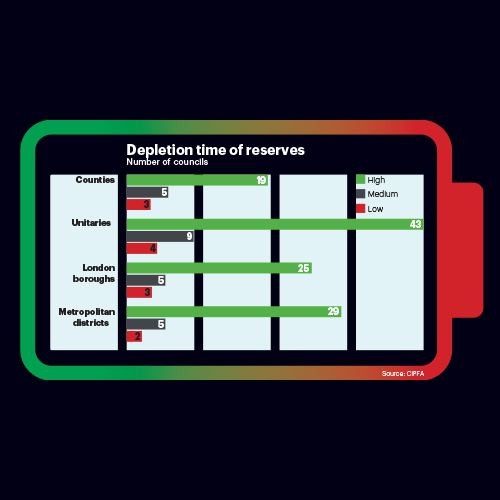 Strength in numbers?
Strength in numbers?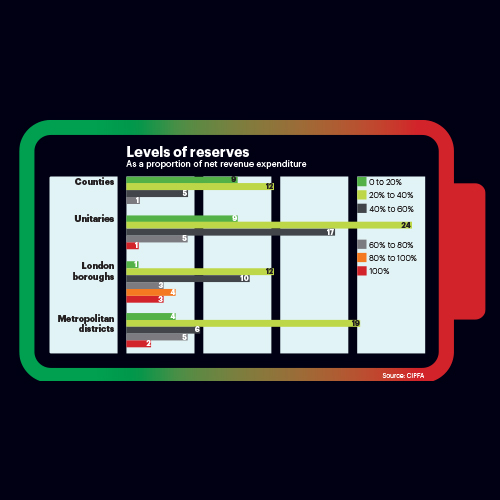
Up to 15% of councils in England are at risk of financial instability, according to early indications from CIPFA’s resilience index.
The institute used a range of indicators, including ‘level’ and ‘change’ of reserves, ‘depletion time of reserves’ and ‘council budget flexibility’ to measure financial resilience, although the tool will be refined further.
Councils were given a high (10+ years), medium (4-10 years) or low (less than 4 years) rating for the time it will take to exhaust their reserves (see above).
Twelve councils record a low score, while a further 24 fall in the medium range. However, the majority of councils have a high depletion time.
A look at the level of reserves as a proportion of expenditure showed great variation, ranging from almost zero to 200% (see below).
Most upper-tier authorities have reserves of 10%-50% of net revenue expenditure. Counties tend to have lower reserves, while most districts (not shown) hold reserves in excess of net annual expenditure.
Mind the gap at the Treasury
At the Treasury, the mean gender pay gap stood at 7% in 2018, down 0.1% from the previous year, although the median gender pay gap rose 1.1% to 14.8%.
The mean gender bonus gap fell significantly from 33.5% to 17.7%, while the median gender bonus gap was eliminated entirely.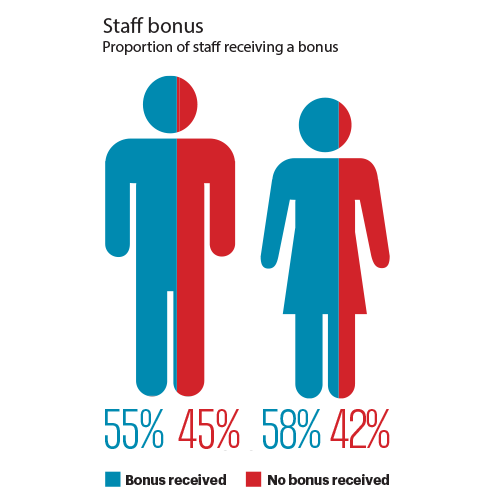
Last year, 58% of men working at the department received a bonus, compared with 55% of women.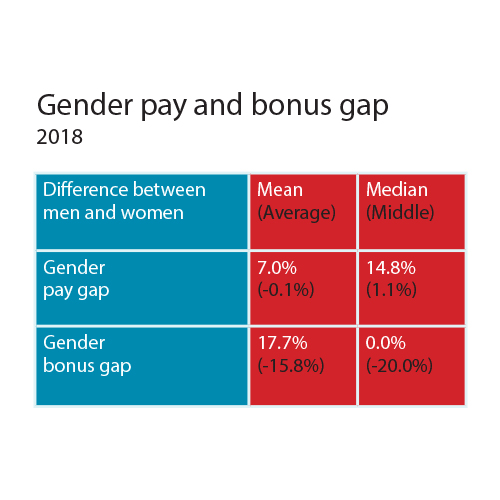
The gender pay gap measures differences in pay between men and women at an organisation regardless of role.
Equal pay measures the pay differential between men and women performing the same role.
No place like 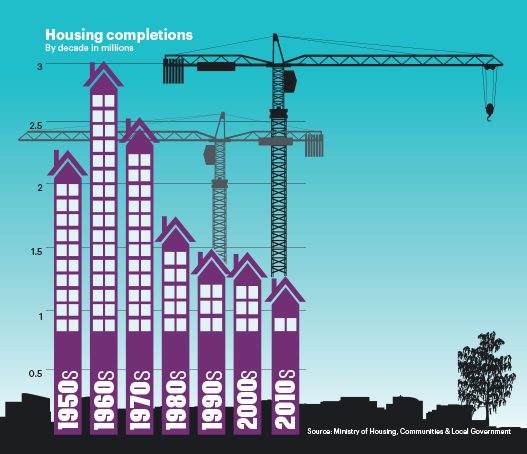 home
home
Figures produced by the Centre for Policy Studies show that fewer houses have been built in England and Wales in the 2010s than in any decade since the Second World War.
It is expected that final figures will show that roughly 1.3 million houses were built between 2010 and 2019, equivalent to 130,000 new homes per year.
There has been consistent decline since the 1960s, when 3 million new units were built. Since then each decade has seen fewer new homes.
There is some good news in that 2017 was the best performing year of the decade so far, with data for 2018 and 2019 still to come.
 Libraries on borrowed time?
Libraries on borrowed time?
Spending on public libraries fell by more than £35m last year, according to CIPFA’s annual survey. Funding levels fell from just over £777.5m in 2016-17 to less than £741.5m last year.
More than 500 full-time library jobs have been cut – a shortfall plugged in part by an increase in the number of volunteers. More than 3,000 volunteers swelled the ranks last year and contributed almost 1.8 million hours of their time.
However, it hasn’t stopped closures. Over 100 service points have shut, putting the number still open at just 3,618. As a result, almost 10 million fewer books were issued last year.
Homeless deaths rise
There were an estimated 597 deaths of homeless people in England and Wales in 2017, a 24% increase over five years, figures released by the Office for National Statistics have indicated. 
This is the first time homeless deaths have been estimated, and the statistics and methodology are subject to further testing and development.
Men accounted for most deaths (84%), and over half resulted from drug poisoning, liver disease or suicide, causes which made up only 3% of overall deaths last year.
The average age of death was 44 for men and 42 for women.
This compares with a mean age of death of 76 for men and 81 for women in the general population in England and Wales. The highest rates of mortality were found in London and the North West of England.



















